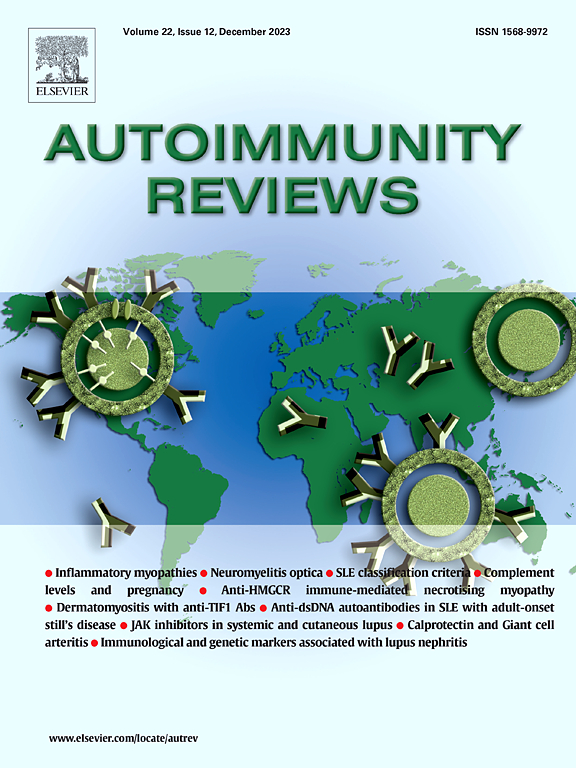S100A8/A9和S100A12在自身免疫性疾病中的作用:机制、生物标志物和治疗潜力
IF 8.3
1区 医学
Q1 IMMUNOLOGY
引用次数: 0
摘要
S100蛋白家族是最大的钙结合蛋白群,在细胞内和细胞外都起着关键的分子调节作用。其中,S100A8/A9和S100A12因其在自身免疫性疾病(AID)发病机制中的作用而受到特别关注。这些蛋白与关键受体相互作用,包括g蛋白偶联受体(gpcr)、toll样受体-4 (TLR4)和晚期糖基化终产物受体(RAGE),驱动先天免疫激活,放大炎症反应,调节免疫细胞功能。S100A8/A9和S100A12的失调与多种自身免疫性疾病的疾病进展密切相关。它们的升高表达与疾病严重程度相关,使其成为监测疾病活动、预测治疗反应和评估疾病进展的有价值的生物标志物。本文综述了S100A8/A9和S100A12在AID中的机制作用,强调了它们的生物标志物潜力和治疗价值。我们进一步讨论了针对S100蛋白、受体、使用小分子抑制剂、基于rna的方法和单克隆抗体的下游信号通路的新兴治疗策略。这些见解凸显了S100A8/A9和S100A12作为疾病指标和干预点的双重前景,为艾滋病的管理提供了新的途径。本文章由计算机程序翻译,如有差异,请以英文原文为准。
The roles of S100A8/A9 and S100A12 in autoimmune diseases: Mechanisms, biomarkers, and therapeutic potential
The S100 protein family, the largest group of calcium-binding proteins, functions as key molecular regulators both intracellularly and extracellularly. Among these, S100A8/A9 and S100A12 have gained particular attention for their roles in the pathogenesis of autoimmune diseases (AID). These proteins interact with pivotal receptors, including G-protein-coupled receptors (GPCRs), toll-like receptor-4 (TLR4), and receptor for advanced glycation end-products (RAGE), driving innate immune activation, amplifying inflammatory responses, and modulating immune cell function. Dysregulation of S100A8/A9 and S100A12 is closely associated with disease progression across multiple autoimmune conditions. Their elevated expression correlates with disease severity, making them valuable biomarkers for monitoring disease activity, predicting therapeutic responses, and assessing disease progression. This review provides an in-depth synthesis of current evidence on the mechanistic roles of S100A8/A9 and S100A12 in AID, emphasizing their biomarker potential and therapeutic value. We further discuss emerging therapeutic strategies that target S100 proteins, their receptors, downstream signaling pathways using small-molecule inhibitors, RNA-based approaches, and monoclonal antibodies. These insights highlight the dual promise of S100A8/A9 and S100A12 as both disease indicators and intervention points, offering novel avenues for the management of AID.
求助全文
通过发布文献求助,成功后即可免费获取论文全文。
去求助
来源期刊

Autoimmunity reviews
医学-免疫学
CiteScore
24.70
自引率
4.40%
发文量
164
审稿时长
21 days
期刊介绍:
Autoimmunity Reviews is a publication that features up-to-date, structured reviews on various topics in the field of autoimmunity. These reviews are written by renowned experts and include demonstrative illustrations and tables. Each article will have a clear "take-home" message for readers.
The selection of articles is primarily done by the Editors-in-Chief, based on recommendations from the international Editorial Board. The topics covered in the articles span all areas of autoimmunology, aiming to bridge the gap between basic and clinical sciences.
In terms of content, the contributions in basic sciences delve into the pathophysiology and mechanisms of autoimmune disorders, as well as genomics and proteomics. On the other hand, clinical contributions focus on diseases related to autoimmunity, novel therapies, and clinical associations.
Autoimmunity Reviews is internationally recognized, and its articles are indexed and abstracted in prestigious databases such as PubMed/Medline, Science Citation Index Expanded, Biosciences Information Services, and Chemical Abstracts.
 求助内容:
求助内容: 应助结果提醒方式:
应助结果提醒方式:


